#Food 🍱 | Drink 🍺
Explore tagged Tumblr posts
Text

The Flavour of Mechanisation
Olive Oil was Revered and Cherished by the ancients. But its Distinctive Peppery Taste is Really a Modern Invention
— By Massimo Mazzotti | 12 November 2024
Few Foods Can Compete With Olive Oil. Its salubrious properties have turned it into one of the most recognisable symbols of healthy living as well as a sign of tacit resistance to the industrialisation of food and loss of authentic flavours. Its rich history, stretching back to the Greeks, Egyptians and Babylonians, plays an enormous part in its ongoing symbolic associations. Across a range of Mediterranean cultures, olive oil has been an inordinately versatile and useful product, even regarded as a means of connecting with the divine. Today, it sells in pricy green bottles that promise a ‘Mediterranean’ lifestyle. And yet, the distinctive flavour of extra virgin olive oil is a modern invention. The trail of its peppery note leads straight to the core of the Industrial Revolution and the reinvention of olive oil as a global commodity.
Homer calls Odysseus polytropos, a man of many ways, who can transform himself and adapt to any situation. Olive oil is often involved in these transformations, as when, on his return to Ithaca, Odysseus relies on olive oil – and Athena’s intervention – to become younger, stronger and more beautiful. He also carved his wedding bed in an olive tree that had grown deeply into the ground. These references are not incidental: the olive tree and the juice of its fruit are ancient symbols of vitality and rootedness. In Mediterranean cultures they signify adaptation, gnarly endurance and endless transformative possibilities.

Amphora depicting olive-gathering, made in Attica, Greece, 520 BCE. Courtesy the British Museum
First domesticated somewhere in the Fertile Crescent, the tree was cultivated by Babylonians, and by the 18th century BCE the Code of Hammurabi regulated the trade in olive oil. The tree steadily inched west, with its main centres of diffusion in Palestine, Syria and Crete. By the 5th century BCE, Thucydides felt he knew what separated civilisation from barbarism: the ability to graft the olive tree. The mythical foundation of Athens begins with the goddess Athena gifting the olive tree to the Greeks. Planting an olive grove was thus a sacred act. Especially revered were those trees whose oil served as prizes for the winners of the Panathenaic Games. In the 4th century BCE, cutting down or uprooting one of those trees could be punished with exile and confiscation of property. To this day in Italy, spilling oil on the table is viewed as a bad omen.
The Romans too loved their olive oil, which they consumed in mindboggling amounts. Monte Testaccio in Rome looks like a natural hill, but it’s an immense pile of broken oil amphoras (tall jars), which were used only once to prevent rancidness. During the imperial age, more than 1 million people lived in Rome, each one consuming an average of two litres of oil per month. How was it even possible? They appreciated oil as food, but they used it mainly for other purposes, such as lighting their houses and anointing their bodies. ‘Wine inside and oil outside,’ sums up Pliny the Elder, who considered olive oil ‘an absolute necessity’ of human life.
It’s not difficult to see why. Due to its antiseptic and calming properties, olive oil was used to clean, treat and beautify the body. In ancient medicine, olive oil was ‘the great healer’, and athletes were given deep friction massages with it to cure and prevent injuries. Warriors, too, smeared themselves with olive oil and used it to prevent their swords from rusting, as it’s an excellent solvent and lubricant. Olive oil also belonged to the world of perfumes. Exotic essences were layered in a clarified olive oil medium to obtain fragrances that were more subtle and persistent than those familiar to us, which are carried by alcohol. Pliny lists a dozen uses for olive oil, including smearing one’s face, hair and teeth with it. ‘The whole Mediterranean,’ wrote Lawrence Durrell, ‘seems to rise in the sour pungent taste of these black olives between the teeth. A taste older than meat, older than wine. A taste as old as cold water.’
The History of Olive Oil is the history of a persistent fascination. An all-pervasive presence across the ancient Mediterranean world, it continued to be seen as the purest and most eloquent way to exhibit close relations with the divine in the monotheist traditions of Judaism, Christianity and Islam. Its allure survived the impact of modernity. Since the 1950s, olive oil has enjoyed a renewed global reputation as a ‘healthy fat’. It is the cornerstone of the so-called Mediterranean Diet, a food pattern that incorporates practices from Greece and southern Italy, and that advertises itself as a salubrious way of life correlated to high life expectancy and low rates of diet-related chronic diseases. Rich in oleic acid and natural antioxidants, olive oil was marketed to American and north European consumers as a solution to the chronic ailments brought on by industrial methods and additives. The diet became an Intangible Cultural Heritage of Humanity in 2013. To imbibe olive oil is to enter into what the anthropologist Anne Meneley calls the ‘imaginaries of the Mediterranean’ as a site of real food and of slow and authentic forms of sociability, the combination responsible, it has been argued, for the higher number of centenarians in this region.
Nostalgia for traditionally made food and its authentic flavours is obviously not unique to olive oil. Oil producers are, however, extraordinarily successful at mobilising nostalgic narratives. The images of an archaic, mythical Mediterranean pervade the labels for what is now often acronymised to EVOO (extra virgin olive oil). The labels contain recurring terms that gesture toward traditional production methods: olives are ‘stone-crushed’, and oil is ‘cold pressed’ or ‘unfiltered’. These terms, like other commonly used descriptors, are not telling you much about the bottle’s content and the sensory experience you’re likely to have. Unlike well-designed wine labels, olive oil labels are mostly about evocation. Those weirdly shaped bottles in dark green glass evoke Mediterranean living, and promise to guard our kitchens against the relentless industrialisation and commodification of food.
Olive Oil Is One of A Handful of Foods Whose Quality Is Legally Determined By Its Flavour
But there is always trouble in paradise. As denounced in Tom Mueller’s book Extra Virginity (2012), the sublime world of olive oil has a scandalous underbelly. Due to its high price and limited supplies, it is one of the most adulterated and mislabelled foods in the world. Pick a bottle of EVOO in a supermarket, and there is a good chance that it would not be recognised as extra virgin by a professional tasting panel. It might even be a concoction of heavily processed low-grade oils stripped of sensory qualities and health benefits, or it might contain substances that have nothing to do with olive juice. Mueller lamented the sheer vagueness of the term ‘olive oil’, which can refer to several different products, including refined industrial oils. And he introduced the reader to the ‘extra virgin’ denomination, which is a way of gesturing toward the authenticity and purity of the product, and of imposing order in an unruly oil world. The denomination dates back to a 1960 European law that created oil grades to standardise quality control and regulate trade. But what does it mean exactly?
I did not fully grasp it until I decided to up my olive oil game, following an interest in the history of olive oil technology. I received technical training at the National Organisation of Oil Tasters (ONAOO) in Imperia, Italy, an association that pioneered the modern tasting method for olive oil. Unlike other food-processing technologies, modern olive oil machinery has been constantly tested and modified based on the resulting flavour of the product. To this day, the oil is one of a handful of foods whose quality is legally determined by its flavour. Intriguingly, flavour was key even when olive oil was not produced for use, primarily, as food. I figured that there must have been a connection between machinic modernity and the ideal flavour of olive oil, which meant I had to learn how to taste it.
Training At ONAOO consists of acquiring a set of skills codified in tasting protocols, which are then used to sort and grade olive oil. This method enables oil tasters to have a shared language, much like the extravagant terms used by wine tasters to convey their sensations. I learned to look for perceptible fruitiness, quantify its presence and discern subtle fragrances and flavours, captured by terms like ‘artichoke’, ‘fresh-cut grass’ or ‘green tomato’. I also learned that bitterness and pepperiness are desirable. Most of the training, however, focused on identifying far less pleasant attributes, labelled by terms like ‘fly’, ‘frost’, ‘heated’, ‘greasy’, ‘mould’, ‘rancid’ or ‘sludge’. They sound disgusting, which they are, no matter how many apples you bite between one sip and the next. These attributes reveal that a problem occurred during the production process – the olives were compromised by a parasite; or not properly processed; or the oil was poorly preserved; or adulterated. An extra virgin olive oil should have no detectable defects. The oil taster is, above all, a defects seeker.
The International Olive Council (IOC) states that the main requirements for an oil to be classified as extra virgin are an absence of defects in its flavour, a perceptible fruitiness, and certain chemical properties – like a free acidity lower than 0.8 per cent. Pepperiness can indicate that the olives were harvested at the right time, before they were fully ripe, and that they were processed promptly, so that no fermentation occurred. This, in turn, is an indicator that this oil’s acidity is likely to be low. Oil acidity cannot be ascertained by tasting, but one can taste flavours that function as proxies for low acidity.
Extra Virginity Evokes A Preindustrial World Where Families Use Ancient Stones To Grind Locally Picked Olives
The IOC also states that extra virgin olive oil must be extracted from olives through a sequence of strictly mechanical operations, such as grinding and pressing or, more commonly today, centrifugation. No chemicals should ever be used, and the temperature during the process should not rise above 80.6°F (27°C). A higher temperature facilitates extraction but alters the oil’s organoleptic (or sensory) properties. Hence the significance of ‘cold pressed’. Strictly speaking, most extra virgin olive oil today is not ‘pressed’, as it’s not processed through presses, let alone stones – and thus ‘cold extraction’ is often a more appropriate descriptor. References to presses and stones gesture toward traditional methods as guarantors of quality.
The myth of traditional methods, however, is questionable. Marcello Scoccia, a blender and sensory analyst at leading companies for the past 40 years, ran the course I took at ONAOO. Cutting an elegant figure, he thoughtfully handles the tasting cup, and firmly believes in what he describes as scientific rigour applied to oil tasting. ‘If you are looking for consistent quality,’ he noted with a smirk, ‘then cutting-edge continuous-cycle mills are the safest bet.’ Continuous cycle means that olives are processed through centrifuges and steel machinery, within a few hours of harvesting. Stones and family-run mills are good for marketing, he conceded, but they are more difficult to operate, and many things can go wrong. And yet, the connection with traditional machinery and methods, however imaginary, is the main way to communicate ‘quality’ to consumers. Extra virginity evokes a romanticised preindustrial world where families use ancient stones to grind locally picked olives.
But how did we come to believe that what was codified in the notion of extra virginity captures the essence of what olive oil is and always was? The underlying assumption is that oil production has a timeless quality, and is based on practices and technology that have stayed constant for centuries, if not millennia, only to be corrupted by new industrial methods between the 19th and 20th century. It’s another version of the misleading narrative that portrays traditional practices as static, non-creative and destined to be wiped away by modern technological innovation. In Silicon Valley’s lore, disruption and radical innovation are positive values. In the case of oil, and food more generally, it’s come to be the opposite: innovation corrupts venerable traditions and threatens people’s health and identities. But the model of change underlying both narratives is similar. And it’s wrong.
Olive Oil Technology has changed enormously through time, with innumerable regional variations. There was never a fixed set of ‘traditional’ machines, but rather shifts in local needs and Mediterranean trading patterns. Inevitably, flavour changed too. Current talk of traditional olive oil-making refers to a set of machines and procedures captured by a familiar imagery: a mill with one or two round stones, and a central screw press, which squeezes mesh bags filled with olive paste. Described as a legacy of a remote past, this technology is said to produce authentic olive oil, the ideal model for our contemporary extra virgin approximation. But how old were these machines, really?

Engraving of olive oil production, attributed to Jan Collaert, based on Jan van der Straet, circa 1594-98. Courtesy the Rijksmuseum, Amsterdam
In fact, they date to the second half of the 18th century, when olive oil production began to be consistently mechanised. At that time, these new standardised machines became popular among southern European oil producers. Described as the ‘new’ oil manufacture, they were perceived as modern and efficient, rooted in analytic reasoning rather than irrational tradition. Stones and presses had long been used, but now they were designed according to new specifications and inserted in an entirely new productive process. To their promoters, the new olive mills were the most visible sign that the spirit of Enlightenment had finally reached the shores of the Mediterranean.
The production of olive oil involved a few basic steps: olives were collected, stored, milled and pressed, then the oil was left to clear in special containers. Enlightened reformers and entrepreneurs modified each stage of this process. Stones for crushing the olives became bigger and were cut to maximise pressure. Mules were replaced with horses, oxen or, wherever possible, vertical waterwheels. Beam presses, an ancient and adaptable technology, were replaced by batteries of central screw presses. These were often mounted into structures that dramatically increased their force.
The Greatest Challenge Was Not Building The Mills, But Convincing Local Labourers To Work In Them
But these modern and powerful mills could function only on one condition: increasing the workload of millers and transforming the nature of their labour. A mechanised plant equipped with two mills and a battery of six reinforced presses could process more than one batch of olives at a time, olive paste moving from one press to the next in an ordered sequence of carefully measured pressings. To operate the mill 24 hours a day demanded a precise choreography. The power source gave continuity to the process, allowing labour to be distributed efficiently, and the steps of the process followed each other so as to keep each machine constantly in use: milling, first pressing, second pressing, third pressing, and the washing of the olive remnants. An optimised Apulian mill of the 1780s could process eight full loads of olives in 48 hours. A local entrepreneur warned that ‘nothing is more damaging to a fully equipped oil mill than being at rest.’
The dawn of the Industrial Revolution in the Mediterranean took the form of modern oil mills. The greatest challenge for entrepreneurs was not building the mills, but convincing local labourers to work in them. Previous oil mills were operated by men and women for a few hours a day during winter, when other demands of farm work slackened. They worked under the guidance of an experienced chief miller, sometimes called a helmsman, who ruled the mill with an authority similar to that of ship captains. Entrepreneurs stripped chief millers of autonomy and implemented the new – mechanised and analytically ordered – productive process. Temporary workers were replaced by brigades of men who worked in shifts around the clock.
Resistance to this new discipline is well documented. Many entrepreneurs hired foreigners, provoking tensions and riots. After many failed experiments, French and Italian entrepreneurs had to give up establishing mechanised mills in certain regions of southern Europe, such as Corsica or Calabria. The trope of the ignorant and recalcitrant Mediterranean peasant-worker was used to explain these failures. In reality, the revolts signalled a crisis in the nascent post-feudal order. By the end of the 18th century, peasant insurrections would target the ‘new men’, the entrepreneurs who supported the philosophical principles of the Enlightenment, the political ideals of the French Revolution, and the analytic management of mechanised production.
Objections To The New Mills went beyond riotous labourers. Some landowners and traders too were sceptical of the new machinery. Why? Weren’t new machines simply better than older ones? Well, it depends. Reformers argued for more powerful machines and for speeding up production. But these goals made sense only to those who were ready to exploit the rising international demand for oil and willing to transform the nature of olive oil to do so.
Most oil mills didn’t need much power because the olives they processed were ripe and already fermented, and thus easy to crush. The oil produced in this way had high acidity, which meant that it could be used for local consumption. It turned rancid fairly quickly, however, and didn’t travel well. By the mid-18th century, it was not suitable for meeting the rising demand for oil from northern Europe and colonial networks. Low acidity oil, by contrast, could preserve its properties when shipped over long distances. Fine low-acidity oils had been manufactured in small quantities since antiquity, mainly for medical and cosmetic purposes. The new trading opportunities turned this kind of oil into a highly profitable business for those Mediterranean elites who could invest in it. But, in order to do so, they needed to change what olive oil was, how it was made – and how it tasted.
To keep acidity low, olives had to be picked directly from the tree, before they were fully ripe. This meant that crushing them was harder: hence more power was needed. Habits and beliefs about storing and fermenting olives had to be swept away, together with entrenched expectations about the colour and flavour of good edible oil. The new oil was sweeter and clearer, with a distinctive peppery note, remarkably different from the pungent and dark oil consumed across the Mediterranean. Not everyone thought it tasted better. The popular classes continued to prefer the ‘common oil’ and, to the apparent surprise of enlightened physicians, they continued to have no trouble digesting it. Southern elites, by contrast, developed a taste for the light and delicate flavour of the new oil. They were, in any case, the only groups who could afford it and, where the new oil became established, everyone else had to consume its cheaper byproducts.
The Delicate And Peppery Flavour of The New Oil Denoted New Forms of Subordination
Admittedly, international demand for olive oil was not yet driven by its value as food. Before 1800, no other known material could outperform olive oil as a fuel for illumination or a lubricant for industrial machinery. But common oil would not do, as it would get rancid too easily. A rancid oil would be smelly and smoky when burned, and it would decompose quickly when used as a lubricant. In the second half of the 18th century, the price of low-acidity oil was published regularly in London, and it could be twice the price of common oil. On a clear day, in the bay of the oil town of Gallipoli in southern Italy, one would count around 70 foreign vessels at anchor, most of them British and Dutch, queuing to be loaded with oil. A British vice-consul resided in town for the sole purpose of fostering the oil trade. It was in this context that the appearance and flavour of low-acidity oil became proxies for its market value as an industrial oil.
Modern oil-making not only brought the Enlightenment to the Mediterranean world, but also new capitalist forms of production. Up to that point, oil making had followed the logic of mixed property and communal rights. Modern oil-making, by contrast, could succeed only where entrepreneurs controlled the entire cycle of production, from harvesting to storage. That is to say, where capitalism reigned uncontested. One key challenge for entrepreneurs was how to discipline the Mediterranean peasant-worker. The delicate and peppery flavour of the new oil didn’t just denote new organoleptic properties but the establishment of new forms of subordination.
Then as now, mechanisation and automation are not neutral. They never are. They do not just speed up older ways of doing things. Historically, they always mark transformations that are social as well as technical. In the case of 18th-century oil technology, what was transformed was not only the machinery but the nature of the product – and of the social world and economic power structures organised around it. New mills and the new oil were not self-evident goals, nor were they determined by an ineluctable technological trajectory. Rather, they were the contested outcomes of a reorganised social life that dictated, among other things, who should benefit from oil production, and how.
Oil Tasting Is A Sombre Task. Tasters handle the tulip-shaped glass as if the oil were brandy, warming it with their palm. They look at the colour of the oil, then smell it to discern its fragrances. Then they take a large sip, and start sucking in air from the corners of their mouth. In this way, they coat their tongue with oil while channelling the aromas up into the nose, so that no flavours will be missed. The loud slurping noise is followed by a quieter sipping and note-taking. Tasting one oil can take up to 15 minutes. What are they looking for?
Behind the colourful descriptors designed to capture each subtle note are the qualities valued by enlightened oil entrepreneurs: flavours that were proxies for low acidity. These indicated that an oil was ready for global trade, and that it would fetch a high price on international markets. They communicated to the connoisseur that the oil was suitable as a long-lasting lubricant or lamp fuel. And also suitable for the refined palates of the affluent Mediterranean bourgeoisie – or, as a Portuguese writer put it – for the ‘delicate tables’. As such, the new flavours mocked the popular taste for common oil, which was now regarded as vulgar and unhealthy. Three centuries after that Mediterranean encounter with industrial capitalism, we are still tasting olive oil to discern whether it’s good for a machine.
Next time you dip a piece of bread into a good olive oil, savour it for a moment, and seek that peppery flavour on the back of your tongue. It’s a flavour that conveys the presence of healthy polyphenols, and that pepperiness is a celebrated protagonist of the Mediterranean lifestyle. Today, it signifies authenticity and a connection to ancient traditions. But that very pepperiness tastes much like the advent of industrial capitalism and the creation of modern power relations in the Mediterranean world. It tastes like the growing network of global shipping routes, and the increasing rotational speed of well-lubricated industrial machinery. It’s a flavour that announced the dawn of a new world, the flavour of mechanisation.
#AEON.Co#Food 🍱 | Drink 🍺#History of Technology#Process and Modernity#Olive 🫒 Oil#Flavour | Mechanisation#Revered#Cherished#Distinctive Peppery#Taste#Modern Invention#Massimo Mazzotti
0 notes
Text
❄️ 𝐌𝐞𝐫𝐫𝐲 𝐂𝐡𝐫𝐢𝐬𝐭𝐦𝐚𝐬 🎄
Hello, my dear readers. I wish all of you, (even those who don't celebrate Christmas), a Merry Christmas. Let this day be peaceful, spent in tranquility and filled with all the positive things you all wish for. Thank you for being here with me. Before you continue your journey throught Tumblr, as a writer, I invite you all to eat, drink and rest here.
Here are the foods:
🍞🥐🥖🥨🥯🥞🧇🧀🍖🍗🥩🥓🍔🍟🍕🌭🥪🌮🌯🥙🧆🥚🥘🍲🍳🍝🍱🍘🍙🍚🍛🍜🍠🍢🍣🍤🍥🥮🍡🥟🥡🍦🍧🍨🍩🎂🍰🧁🥧🍫🍬🍭🍮🍯
Here are the drinks:
🥛☕🍵🍶🍾🍷🍸🍹🍺🍻🥂🥃🧃🧉
And here is your present: 🎁
Hope to hear from you again and have a wonderful, wonderful day (even it it's not daytime)!
@shooting-love-arrows
34 notes
·
View notes
Text


hey stars lb.
take some drinks and food
🍒🫐🍓🍔🥗🥪🍱🍦🍭🍡🍫🍿🧃🥤🧋🍺🍺🍺🍺🥃🥃🥃🥃🍻🍻🍻🍻🥂🥂🥂🍷🍷🍷🍹🍹🍹🍸🍸🍸🍾🍾🍾🍾
7 notes
·
View notes
Text
Emoji Bank
Smilies and Emotions (496)😀😃😄😁😆😅😂🤣😭😉😗😙😚😘🥰😍🤩🥳🫠🙃🙂🥲🥹😊☺️😌😏😴😪🤤😋😛😝😜🤪🥴😔🥺😬🫥😑😐😶😶🌫️🤐🫡🤔🤫🫢🤭🥱🤗🫣😱🤨🧐😒🙄😮💨😤😠😡🤬😞😓😟😥😢☹️🙁🫤😕😰😨😧😦😮😯😲😳🤯😖😣😩😫😵😵💫🫨🥶🥵🤢🤮🤧🤒🤕😷🤥😇🤠🤑🤓😎🥸🤡😈👿👻🎃💩🤖👽👾🌛🌜🌚🌝🌞☠️👹👺🔥💯💫⭐🌟✨💥💨💦💤🕳️🎉🙈🙉🙊😺😸😹😻😼😽🙀😿😾❤️🧡💛💚🩵💙💜🤎🖤🩶🤍🩷💘💝💖💗💓💞💕💌💟♥️❣️❤️🩹💔❤️🔥💋🫂👥👤🗣️👣🧠🫀🫁🩸🦠🦷🦴💀👀👁️👄🫦👅👃👂🦻🦶🦵🦿🦾💪👏👍👎🫶🙌👐🤲🤝🤜🤛✊👊🫳🫴🫱🫲🫸🫷👋🤚🖐️✋🖖🤟🤘✌️🤞🫰🤙🤌🤏👌🫵👉👈☝️👆👇🖕✍️🤳🙏💅People(354)🙇🙋💁🙆🙅🤷🤦🙍🙎🧏💆💇🧖🛀🛌🧘🧑🦯🧑🦼🧑🦽🧎🧍🚶🏃🤸🏋️⛹️🤾🚴🚵🧗🤼🤹🏌️🏇🤺⛷️🏂🪂🏄🚣🏊🤽🧜🧚🧞🧝🧙🧛🧟🧌🦸🦹🥷🧑🎄👼💂🫅🤵👰🧑🚀👷👮🕵️🧑✈️🧑🔬🧑💻🧑⚕️🧑🔧🧑🏭🧑🚒🧑🌾🧑🏫🧑🎓🧑💼🧑⚖️🧑🏿🎤🧑🎨🧑🍳👳🧕👲👶🧒🧑🧓🧑🦳🧑🦰👱🧑🦱🧑🦲🧔🕴️💃🕺👯🧑🤝🧑👭👬👫💏👩❤️💋👨👨❤️💋👨👩❤️💋👩💑👩❤️👨👨❤️👨👩❤️👩🫄🤱🧑🍼👪Animals and Nature(469)💐🌹🥀🌺🌷🪷🌸💮🏵️🪻🌻🌼🍂🍁🍄🌾🌱🌿🍃☘️🍀🪴🌵🌴🌳🌲🪵🪹🪺🪨⛰️🏔️❄️☃️⛄🌫️🌡️🔥🌋🏜️🏞️🏝️🏖️🌅🌄🌈🫧🌊🌬️🌀🌪️⚡☔💧🌧️🌩️⛈️🌨️☁️🌦️🌥️⛅🌤️☀️🌞🌝🌚🌜🌛⭐🌟✨💫🌙☄️🕳️🌠🌌🌍🌎🌏🪐🌑🌒🌓🌔🌕🌖🌗🌘🙈🙉🙊🐵🦁🐯🐱🐶🐺🐻🐻❄️🐨🐼🐹🐭🐰���🦝🐮🐷🐽🐗🦓🦄🐴🫎🐲🦎🐉🦖🦕🐢🐊🐍🐸🐇🐁🐀🐈🐈⬛🐩🐕🦮🐕🦺🐖🐎🫏🐄🐂🐃🦬🐏🐑🐐🐆🐅🦌🦙🦥🦘🐘🦣🦏🦛🦒🐒🦍🦧🐪🐫🐿️🦫🦨🦡🦔🦦🦇🪽🪶🐦🐦⬛🐓🐔🐣🐤🐥🦅🦉🦜🕊️🦤🦢🦆🪿🦩🦚🦃🐧🦭🦈🐬🐋🐳🐟🐠🐡🦐🦞🦀🦑🐙🪼🦪🪸🦂🕷️🕸️🐚🐌🐜🦗🪲🦟🪳🪰🐝🐞🦋🐛🪱🦠🐾Food and Drink(259)🍓🍒🍎🍉🍑🍊🥭🍍🍌🍋🍈🍏🍐🥝🫒🫐🍇🥥🍅🌶️🫚🥕🍠🧅🌽🥦🥒🥬🫛🫑🥑🍆🧄🥔🫘🌰🥜🍞🫓🥐🥖🥯🧇🥞🍳🥚🧀🥓🥩🍗🍖🍔🌭🥪🥨🍟🍕🫔🌮🌯🥙🧆🥘🍝🥫🫕🥣🥗🍲🍛🍜🦪🦞🍣🍤🥡🍚🍱🥟🍢🍙🍘🍥🍡🥠🥮🍧🍨🍦🥧🍰🍮🎂🧁🍭🍬🍫🍩🍪🍯🧂🧈🍿🧊🫙🥤🧋🧃🥛🍼🍵☕🫖🧉🍺🍻🥂🍾🍷🥃🫗🍸🍹🍶🥢🍴🥄🔪🍽️Travel and Places(245)🛑🚧🚨⛽🛢️🧭🛞🛟⚓🚏🚇🚥🚦🛴🦽🦼🩼🚲🛵🏍️🚙🚗🛻🚐🚚🚛🚜🏎️🚒🚑🚓🚕🛺🚌🚈🚝🚅🚄🚂🚃🚋🚎🚞🚊🚉🚍🚔🚘🚖🚆🚢🛳️🛥️🚤⛴️⛵🛶🚟🚠🚡🚁🛸🚀✈️🛫🛬🛩️🛝🎢🎡🎠🎪🗼🗽🗿🗻🏛️💈⛲⛩️🕍🕌🕋🛕⛪💒🏩🏯🏰🏗️🏢🏭🏬🏪🏟️🏦🏫🏨🏣🏤🏥🏚️🏠🏡🏘️🛖⛺🏕️⛱️🏙️🌆🌇🌃🌉🌁🛤️🛣️🗾🗺️🌐💺🧳Activities and Events(239)🎉🎊🎈🎂🎀🎁🎇🎆🧨🧧🪔🪅🪩🎐🎏🎎🎑🎍🎋🎄🎃🎗️🥇🥈🥉🏅🎖️🏆📢⚽⚾🥎🏀🏐🏈🏉🥅🎾🏸🥍🏏🏑🏒🥌🛷🎿⛸️🛼🩰🛹⛳🎯🏹🥏🪃🪁🎣🤿🩱🎽🥋🥊🎱🏓🎳♟️🪀🧩🎮🕹️👾🔫🎲🎰🎴🀄🃏🪄🎩📷📸🖼️🎨🖌️🖍️🪡🧵🧶🎹🎷🎺🎸🪕🎻🪘🥁🪇🪈🪗🎤🎧🎚️🎛️🎙️📻📺📼📹📽️🎥🎞️🎬🎭🎫🎟️Objects(552)📱☎️📞📟📠🔌🔋🪫🖲️💽💾💿📀🖥️💻⌨️🖨️🖱️🪙💸💵💴💶💷💳💰🧾🧮⚖️🛒🛍️🕯️💡🔦🏮🧱🪟🪞🚪🪑🛏️🛋️🚿🛁🚽🧻🪠🧸🪆🧷🪢🧹🧴🧽🧼🪥🪒🪮🧺🧦🧤🧣👖👕🎽👚👔👗👘🥻🩱👙🩳🩲���🥼🦺⛑️🪖🎓🎩👒🧢👑🪭🎒👝👛👜💼🧳☂️🌂💍💎💄👠👟👞🥿🩴👡👢🥾🦯🕶️👓🥽⚗️🧫🧪🌡️💉💊🩹🩺🩻🧬🔭🔬📡🛰️🧯🪓🪜🪣🪝🧲🧰🗜️🔩🪛🪚🔧🔨⚒️🛠️⛏️⚙️🔗⛓️📎🖇️📏📐🖌️🖍️🖊️🖋️✒️✏️📝📖📚📒📔📕📓📗📘📙🔖🗒️📄📃📋📑📂📁🗂️🗃️🗄️📊📈📉📇🪪📌📍✂️📭🗑️📰🗞️🏷️📦📫📪📬📭📮✉️📧📩📨💌📤📥🗳️🕛🕧🕐🕜🕑🕝🕒🕞🕓🕟🕔🕠🕕🕡🕖🕢🕗🕣🕘🕤🕙🕥🕚🕦⏱️⌚🕰️⌛⏳⏲️⏰📅📆🗓️🪧🛎️🔔📯📢📣🔍🔎🔮🧿🪬📿🏺⚱️⚰️🪦🚬💣🪤📜⚔️🗡️🛡️🗝️🔑🔐🔏🔒🔓Symbols(508)🔴🟠🟡🟢🔵🟣🟤⚫⚪🟥🟧🟨🟩🟦🟪🟫⬛⬜❤️🧡💛💚💙💜🤎🖤🤍🩷🩵🩶♥️♦️♣️♠️♈♉♊♋♌♍♎♏♐♑♒♓⛎♀️♂️⚧️💭🗯️💬🗨️❕❗❔❓⁉️‼️⭕❌🚫🚳🚭🚯🚱🚷📵🔞🔕🔇🅰️🆎🅱️🅾️🆑🆘🛑⛔📛♨️💢🔻🔺🉐㊙️㊗️🈴🈵🈹🈲🉑🈶🈚🈸🈺🈷️✴️🔶🔸🔆🔅🆚🎦📶🔁🔂🔀▶️⏩⏭️⏯️◀️⏪⏮️🔼⏫🔽⏬⏸️⏹️⏺️⏏️📴🛜📳📲🔈🔉🔊🎼🎵🎶☢️☣️⚠️🚸⚜️🔱〽️🔰✳️❇️♻️💱💲💹🈯❎✅✔️☑️⬆️↗️➡️↘️⬇️↙️⬅️↖️↕️↔️↩️↪️⤴️⤵️🔃🔄🔙🔛🔝🔚🔜🆕🆓🆙🆗🆒🆖ℹ️🅿️🈁🈂️🈳🔣🔤🔠🔡🔢#️⃣*️⃣0️⃣1️⃣2️⃣3️⃣4️⃣5️⃣6️⃣7️⃣8️⃣9️⃣🔟💠🔷🔹🌐🏧Ⓜ️🚾🚻🚹🚺♿🚼🛗🚮🚰🛂🛃🛄🛅💟⚛️🛐🕉️☸️☮️☯️☪️🪯✝️☦️✡️🔯🕎♾️🆔⚕️✖️➕➖➗🟰➰➿〰️©️®️™️🔘🔳◼️◾▪️🔲◻️◽▫️👁️🗨️Flags(1102)🏁🚩🎌🏴🏳️🏳️🌈🏳️⚧️🏴☠️🇦🇨🇦🇩🇦🇪🇦🇫🇦🇬🇦🇮🇦🇱🇦🇲🇦🇴🇦🇶🇦🇷🇦🇸🇦🇹🇦🇺🇦🇼🇦🇽🇦🇿🇧🇦🇧🇧🇧🇩🇧🇪🇧🇫🇧🇬🇧🇭🇧🇮🇧🇯🇧🇱🇧🇲🇧🇳🇧🇴🇧🇶🇧🇷🇧🇸🇧🇹🇧🇻🇧🇼🇧🇾🇧🇿🇨🇦🇨🇨🇨🇩🇨🇫🇨🇬🇨🇭🇨🇮🇨🇰🇨🇱🇨🇲🇨🇳🇨🇴🇨🇵🇨🇷🇨🇺🇨🇻🇨🇼🇨🇽🇨🇾🇨🇿🇩🇪🇩🇬🇩🇯🇩🇰🇩🇲🇩🇴🇩🇿🇪��🇪🇨🇪🇪🇪🇬🇪🇭🇪🇷🇪🇸🇪🇹🇪🇺🇫🇮🇫🇯🇫🇰🇫🇲🇫🇴🇫🇷🇬🇦🇬🇧🇬🇩🇬🇪🇬🇫🇬🇬🇬🇭🇬🇮🇬🇱🇬🇲🇬🇳🇬🇵🇬🇶🇬🇷🇬🇸🇬🇹🇬🇺🇬🇼🇬🇾🇭🇰🇭🇲🇭🇳🇭🇷🇭🇹🇭🇺🇮🇨🇮🇩🇮🇪🇮🇱🇮🇲🇮🇳🇮🇴🇮🇶🇮🇷🇮🇸🇮🇹🇯🇪🇯🇲🇯🇴🇯🇵🇰🇪🇰🇬🇰🇭🇰🇮🇰🇲🇰🇳🇰🇵🇰🇷🇰🇼🇰🇾🇰🇿🇱🇦🇱🇧🇱🇨🇱🇮🇱🇰🇱🇷🇱🇸🇱🇹🇱🇺🇱🇻🇱🇾🇲🇦🇲🇨🇲🇩🇲🇪🇲🇫🇲🇬🇲🇭🇲🇰🇲🇱🇲🇲🇲🇳🇲🇴🇲🇵🇲🇶🇲🇷🇲🇸🇲🇹🇲🇺🇲🇻🇲🇼🇲🇽🇲🇾🇲🇿🇳🇦🇳🇨🇳🇪🇳🇫🇳🇬🇳🇮🇳🇱🇳🇴🇳🇵🇳🇷🇳🇺🇳🇿🇴🇲🇵🇦🇵🇪🇵🇫🇵🇬🇵🇭🇵🇰🇵🇱🇵🇲🇵🇳🇵🇷🇵🇸🇵🇹🇵🇼🇵🇾🇶🇦🇷🇪🇷🇴🇷🇸🇷🇺🇷🇼🇸🇦🇸🇧🇸🇨🇸🇩🇸🇪🇸🇬🇸🇭🇸🇮🇸🇯🇸🇰🇸🇱🇸🇲🇸🇳🇸🇴🇸🇷🇸🇸🇸🇹🇸🇻🇸🇽🇸🇾🇸🇿🇹🇦🇹🇨🇹🇩🇹🇫🇹🇬🇹🇭🇹🇯🇹🇰🇹🇱🇹🇲🇹🇳🇹🇴🇹🇷🇹🇹🇹🇻🇹🇼🇹🇿🇺🇦🇺🇬🇺🇲🇺🇳🇺🇸🇺🇾🇺🇿🇻🇦🇾🇪🇻🇨🇾🇹🇻🇪🇿🇦🇻🇬🇿🇲🇻🇮🇿🇼🇻🇳🏴🇻🇺🏴🇼🇫🏴🇼🇸🇽🇰
1 note
·
View note
Text
AND THERES.. a chillzo plushie only if Reblog if

C H I L L Z O P L U S H Y

AND A .. C H I P L U S H ✨✨✨✨✨✨✨
( fun fact every time u get one (or both) u save the world) 🌍💞♥️💖💞💗
Shop update: AIGHT SO HERE YALL GO
Drinks (if you like / heart this post ) :🥤🧋🧃🥛🍼🍵☕🫖🍺🍻🥂🍾🍷🥃🍸🍹🍶
Food if you Reblog, and you have to put the emoji of what you got : 🍔🌭🥪🥨🍟🍕🫔🌮🌯🥙🧆🥘🍝🥣🥗🍲🍛🍜🍣🍤🥡🍚🍱🥟🍢🍙
Sweets if you reply (you have to put the sweet u got in yo reply ): 🍥🍡🥮🍧🍨🍦🥧🍰🍮🎂🧁🍭🍬🍫🍩🍪🍯
And fruits and vegetables if you do all : 🫐🍊🍑🍉🍎🍒🍓🥭🍍🍌🍋🍈🍏🍐🥝🫒🫐🍇🥥🍅🌶️🥕🍠🌽🥦🥒🥔🥑🧄🫑🫛🥬🌰🥜🍞🫓🥐🥖🥚🧀
NEW PINNED POST
Hoi im chillzo.
I'm non binary and pansexual
If you wanna be a meme we come on down
And join the chill club!!!




Rules
Don't be rude
Love the trans ppl that come into the club
Be nice... To chi she's about 5 maybe..
WE LOVE ALL PEOPLE BUT NOT WEIRDOS, BAD PEOPLE (but we take baddies aka chill people. ) AND HECK(HELL) NO TO PEDOS
we have a lil store here so if you Reblog you get:[🍦🍬🍫🍩🍪🍮🍿🧋☕🍹🧃]
If you like❤️, *this is were most the foods at lol*:{🧁🍧🍨🥧🍢🥟🍱🍚🥡🍤🫕🥫🍝🍕🌮🌯🥙🍔🌭🥪🥘🍳🥞🧇🥯🥃🍾🍷🥂🍻🍺🍯🍰🦞🥫🥓🥚🫐🍇🍌🫖} and heres your fork and knife (🍴)
Wait btw im putting every chillzo picrew here as well, might get updates here and there.






63 notes
·
View notes
Note
Hey so, idk if this was an actual thing or just a weird fever dream thing I came up with but, I've been trying to find this one fic that I could almost swear was an actual thing (tho I haven't been able to find it) where Izu has afo (the quirk) and All Might gave him ofa but didn't tell him that or about the quirk at all and Izu is going nuts thinking that he's been sleepwalking and stealing people's quirks and breaking his bones with ofa, but I can't find it anywhere. Does this sound at all familiar to you or your fic finders? If anyone can help me I would really appreciate it. And here's some encouragement/appreciation in the form of food and drinks: 🍉🍞🥐🥖🫓🥨🥯🥞🧇🧀🧀🧀🧀🍔🍟🍕🌭🥪🌮🌯🥣🥙🥘🍲🫕🥣🥗🍖🍗🥩🥓🧆🥚🍳🍿🍘🍱🍙🍚🍛🍜🍝🍢🍣🍤🍥🥮🍡🥟🥠🥡🍦🍧🍨🍩🍪🎂🍰🧁🥧🍫🍬🍭🍮🥛☕🫖🍵🍶🍾🍷🍸🍹🍺🍻🥂🥃🥤🧋🧃🧉
Fic finders, ASSEMBLE!
50 notes
·
View notes
Text
emoji masterpost
smileys and emotions
😀😃😄😁😆😅😂🤣😭😉😗😙😚😘🥰😍🤩🥳🙃🙂🥲🥹😋😛😝😜🤪😇😊☺️😏😌😔😑😐😶🫡🤔🤫🫢🤭🥱🤗🫣😱🤨🧐😒🙄😮💨😤😠😡🤬🥺😟😥😢☹️🙁🫤😕🤐😰😨😧😦😮😯😲😳🤯😬😓😞😖😣😩😫😵😵💫🫥😴😪🤤🌛🌜🌚🌝🌞🫠😶🌫️🥴🥵🥶🤢🤮🤧🤒🤕😷🤠🤑😎🤓🥸🤥🤡👻💩👽🤖🎃😈👿👹👺🔥💫⭐🌟✨💥💯💢💨💦🫧💤🕳️🎉🎊🙈🙉🙊😺😸😹😻😼😽🙀😿😾❤️🧡💛💚💙💜🤎🖤🤍♥️💘💝💖💗💓💞💕💌💟❣️❤️🩹💔❤️🔥💋🫂👥👤🗣️👣🧠🫀🫁🩸🦠🦷🦴☠️💀👀👁️👄🫦👅👃👂🦻🦶🦵🦿🦾💪👍👎👏🫶🙌👐🤲🤝🤜🤛✊👊🫳🫴🫱🫲🤚👋🖐️✋🖖🤟🤘✌️🤞🫰🤙🤌🤏👌🖕☝️👆👇👉👈🫵✍️🤳🙏💅
people
🙇🙋💁🙆🙅🤷🤦🙍🙎🧏💆💇🧖🛀🛌🧘🧑🦯🧑🦼🧑🦽🧎🧍🚶🏃🤸🏋️⛹️🤾🚴🚵🧗🤼🤹🏌️🏇🤺⛷️🏂🪂🏄🚣🏊🤽🧜🧚🧞🧝🧙🧛🧟🧌🦸🦹🥷🎅👼💂🫅🤵👰🧑🚀👷👮🕵️🧑✈️🧑🔬��⚕️🧑🔧🧑🏭🧑🚒🧑🌾🧑🏫🧑🎓🧑💼🧑⚖️🧑💻🧑🎤🧑🎨🧑🍳👳🧕👲👶🧒🧑🧓🧑🦳🧑🦰👱🧑🦱🧑🦲🧔🕴️💃🕺👯🧑🤝🧑👭👬👫💏👩❤️💋👨👨❤️💋👨👩❤️💋👩💑👩❤️👨👨❤️👨👩❤️👩🫃🤱🧑🍼👨👨👦
animals and nature
💐🌹🥀🌺🌷🪷🌸💮🏵️🌻🌼🍂🍁🍄🌾🌱🌿🍃☘️🍀🪴🌵🌴🌳🌲🪹🪺🪵🪨⛰️🏔️❄️☃️⛄🌊🫧🌬️🌀🌪️🌁🌫️🌡️🔥🌋🏜️🏞️🏖️⛱️🌅🌄☀️🌤️⛅🌥️🌦️☁️🌨️⛈️🌩️🌧️💧☔⚡🌈⭐🌟💫✨🌙☄️🌠🌌🪐🌑🌒🌓🌔🌕🌖🌗🌘🌍🌎🌏🙈🙉🙊🐵🦁🐯🐱🐶🐺🐻🐻❄️🐨🐼🐹🐭🐰🦊🦝🐮🐷🐽🐗🦓🦄🐴🐸🐲🦎🐉🦖🦕🐢🐊🐍🐁🐀🐇🐈🐈⬛🐩🐕🦮🐕🦺🐅🐆🐎🐖🐄🐂🐃🦬🐏🐑🐐🦌🦙🦥🦘🐘🦣🦏🦛🦒🐒🦍🦧🐪🐫🐿️🦫🦨🦡🦔🦦🦇🪶🦅🦉🐓🐔🐣🐤🐥🐦🦜🕊️🦤🦢🦩🦚🦃🦆🐧🦭🦈🐬🐋🐳🐟🐠🐡🦐🦞🦀🦑🐙🦪🪸🦂🕷️🕸️🐚🐌🐜🦗🪲🦟🪳🪰🐝🐞🦋🐛🪱🦠🐾
food and drink
🍓🍒🍎🍉🍑🍊🥭🍍🍌🍋🍈🍏🍐🥝🫒🫐🍇🥥🍅🌶️🥕🍠🧅🌽🥦🥒🥬🫑🥑🍆🧄🥔🫘🌰🥜🍞🫓🥐🥖🥯🧇🥞🍳🥚🧀🥓🥩🍗🍖🍔🌭🥪🥨🍟🍕🫔🌮🌯🥙🧆🥘🍝🥫🫕🥣🥗🍲🍛🍜🦪🦞🍣🍤🥡🍚🍱🥟🍢🍙🍘🍥🍡🥠🥮🍧🍨🍦🥧🍰🍮🎂🧁🍭🍬🍫🍩🍪🍯🧂🧈🍿🧊🫙🥤🧋🧃🥛🍼🍵☕🫖🧉🍺🍻🥂🍾🍷🥃🫗🍸🍹🍶🥢🍴🥄🔪🍽️
travel and places
🛑🚧🚨⛽🛢️🧭🛞🛟⚓🚏🚇🚥🚦🛴🦽🦼🩼🚲🛵🏍️🚙🚗🛻🚐🚚🚛🚜🏎️🚒🚑🚓🚕🛺🚌🚈🚝🚅🚄🚂🚃🚋🚎🚞🚊🚉🚍🚔🚘🚖🚆🚢🛳️🛥️🚤⛴️⛵🛶🚟🚠🚡🚁🛸🚀✈️🛫🛬🛩️🛝🎢🎡🎠🎪🗼🗽🗿🗻🏛️💈⛲⛩️🕍🕌🕋🛕⛪💒🏩🏯🏰🏗️🏢🏭🏬🏪🏟️🏦🏫🏨🏣🏤🏥🏚️🏠🏡🏘️🛖⛺🏕️🏙️🌆🌇🌃🌉🌁🛤️🛣️🏝️🗾🗺️🌐💺🧳
activities and events
🎉🎊🎈🎂🎀🎁🎇🎆🧨🧧🪔🪅🪩🎐🎏🎎🎑🎍🎋🎄🎃🎗️🥇🥈🥉🏅🎖️🏆📢⚽⚾🥎🏀🏐🏈🏉🎾🥅🏸🥍🏏🏑🏒🥌🛷🎿⛸️🛼🩰🛹⛳🎯🏹🥏🪃🪁🎣🤿🩱🎽🥋🥊🎱🏓🎳♟️🪀🧩🎮🕹️👾🔫🎲🎰🎴🀄🃏🪄🎩📷📸🖼️🎨🖌️🖍️🪡🧵🧶🎹🎷🎺🎸🪕🎻🪘🥁🪗🎤🎧🎚️🎛️🎙️📻📺📼📹📽️🎥🎞️🎬🎭🎫🎟️
objects
📱☎️📞📟📠🔌🔋🪫🖲️💽💾💿📀🖥️💻⌨️🖨️🖱️🪙💸💵💴💶💷💳💰🧾🧮⚖️🛒🛍️🕯️💡🔦🏮🧱🪟🪞🚪🪑🛏️🛋️🚿🛁🚽🧻🪠🧸🪆🧷🪢🧹🧴🧽🧼🪥🪒🧺🧦🧤🧣👖👕🎽👚👔👗👘🥻🩱👙🩳🩲🧥🥼🦺⛑️🪖🎓🎩👒🧢👑🎒👝👛👜💼🧳☂️🌂💍💎💄👠👟👞🥿🩴👡👢🥾👓🕶️🦯🥽⚗️🧫🧪🌡️🧬💉💊🩹🩺🩻🔭🔬📡🛰️🧯🪓🪜🪣🪝🧲🧰🗜️🔩🪛🪚🔧🔨⚒️🛠️⛏️⚙️🔗⛓️📎🖇️📏📐✂️📌📍🗑️🖌️🖍️🖊️🖋️✒️✏️📝📒📔📕📓📗📘📙📚📖🔖🗒️📄📃📋📇📑🗃️🗄️🗂️📂📁📰🗞️📊📈📉🪧🪪🏷️📦📫📪📬📭📮✉️📧📩📨💌📤📥🗳️⏱️🕛🕧🕐🕜🕑🕝🕒🕞🕓🕟🕔🕠🕕🕡🕖🕢🕗🕣🕘🕤🕙🕥🕚🕦⌛⏳🕰️⌚⏲️⏰🗓️📅📆🛎️🔔📯📢📣🔍🔎🔮🧿🪬📿🏺⚱️⚰️🪦🚬💣🪤📜⚔️🗡️🛡️🗝️🔑🔐🔏🔒🔓
symbols
❤️🧡💛💚💙💜🤎🖤🤍🔴🟠🟡🟢🔵🟣🟤⚫⚪🟥🟧🟨🟩🟦🟪🟫⬛⬜♈♉♊♋♌♍♎♏♐♑♒♓⛎♀️♂️⚧️🔻🔺❕❗❔❓⁉️‼️⭕❌🚫🚳🚭🚯🚱🚷📵🔞🔕🔇🅰️🆎🅱️🅾️🆑🆘🛑⛔📛♨️🉐㊙️㊗️🈴🈵🈹🈲🉑🈶🈚🈸🈺🈷️🔶🔸🔆🔅✴️🆚🎦📶🔁🔂🔀▶️⏩⏭️⏯️◀️⏪⏮️🔼⏫🔽⏬⏸️⏹️⏺️⏏️📴📳📲🔈🔉🔊🎼🎵🎶☢️☣️⚠️🚸⚜️🔱〽️🔰✳️❇️♻️💱💲💹🈯❎✅✔️☑️⬆️↗️➡️↘️⬇️↙️⬅️↖️↕️↔️↩️↪️⤴️⤵️🔃🔄🔙🔛🔝🔚🔜🆕🆓🆙🆗🆒🆖ℹ️🅿️🈁🈂️🈳🔣🔤🔠🔡🔢#️⃣*️⃣0️⃣1️⃣2️⃣3️⃣4️⃣5️⃣6️⃣7️⃣8️⃣9️⃣🔟💠🔷🔹🌐🏧Ⓜ️🚾🚻🚹🚺♿🚼🛗🚮🚰🛂🛃🛄🛅💟⚛️🛐🕉️☸️☮️☯️☪️✝️☦️✡️🔯🕎♾️🆔⚕️✖️➕➖➗🟰➰➿〰️©️®️™️♥️♦️♣️♠️🔘🔳◼️◾▪️🔲◻️◽▫️💭🗯️💬🗨️👁️🗨️
flags
🏁🚩🎌🏴🏳️🏳️🌈🏳️⚧️🏴☠️🇦🇨🇦🇩🇦🇪🇦🇫🇦🇬🇦🇮🇦🇱🇦🇲🇦🇴🇦🇶🇦🇷🇦🇸🇦🇹🇦🇺🇦🇼🇦🇽🇦🇿🇧🇦🇧🇧🇧🇩🇧🇪🇧🇫🇧🇬🇧🇭🇧🇮🇧🇯🇧🇱🇧🇲🇧🇳🇧🇴🇧🇶🇧🇷🇧🇸🇧🇹🇧🇻🇧🇼🇧🇾🇧🇿🇨🇦🇨🇨🇨🇩🇨🇫🇨🇬🇨🇭🇨🇮🇨🇰🇨🇱🇨🇲🇨🇳🇨🇴🇨🇵🇨🇷🇨🇺🇨🇻🇨🇼🇨🇽🇨🇾🇨🇿🇩🇪🇩🇬🇩🇯🇩🇰🇩🇲🇩🇴🇩🇿🇪🇦🇪🇨🇪🇪🇪🇬🇪🇭🇪🇷🇪🇸🇪🇹🇪🇺🇫🇮🇫🇯🇫🇰🇫🇲🇫🇴🇫🇷🇬🇦🇬🇧🇬🇩🇬🇪🇬🇫🇬🇬🇬🇭🇬🇮🇬🇱🇬🇲🇬🇳🇬🇵🇬🇶🇬🇷🇬🇸🇬🇹🇬🇺🇬🇼🇬🇾🇭🇰🇭🇲🇭🇳🇭🇷🇭🇹🇭🇺🇮🇨🇮🇩🇮🇪🇮🇱🇮🇲🇮🇳🇮🇴🇮🇶🇮🇷🇮🇸🇮🇹🇯🇪🇯🇲🇯🇴🇯🇵🇰🇪🇰🇬🇰🇭🇰🇮🇰🇲🇰🇳🇰🇵🇰🇷🇰🇼🇰🇾🇰🇿🇱🇦🇱🇧🇱🇨🇱🇮🇱🇰🇱🇷🇱🇸🇱🇹🇱🇺🇱🇻🇱🇾🇲🇦🇲🇨🇲🇩🇲🇪🇲🇫🇲🇬🇲🇭🇲🇰🇲🇱🇲🇲🇲🇳🇲🇴🇲🇵🇲🇶🇲🇷🇲🇸🇲🇹🇲🇺🇲🇻🇲🇼🇲🇽🇲🇾🇲🇿🇳🇦🇳🇨🇳🇪🇳🇫🇳🇬🇳🇮🇳🇱🇳🇴🇳🇵🇳🇷🇳🇺🇳🇿🇴🇲🇵🇦🇵🇪🇵🇫🇵🇬🇵🇭🇵🇰🇵🇱🇵🇲🇵🇳🇵🇷🇵🇸🇵🇹🇵🇼🇵🇾🇶🇦🇷🇪🇷🇴🇷🇸🇷🇺🇷🇼🇸🇦🇸🇧🇸🇨🇸🇩🇸🇪🇸🇬🇸🇭🇸🇮🇸🇯🇸🇰🇸🇱🇸🇲🇸🇳🇸🇴🇸🇷🇸🇸🇸🇹🇸🇻🇸🇽🇸🇾🇸🇿🇹🇦🇹🇨🇹🇩🇹🇫🇹🇬🇹🇭🇹🇯🇹🇰🇹🇱🇹🇲🇹🇳🇹🇴🇹🇷🇹🇹🇹🇻🇹🇼🇹🇿🇺🇦🇺🇬🇺🇲🇺🇳🇺🇸🇺🇾🇺🇿🇻🇦🇻🇨🇻🇪🇻🇬🇻🇮🇻🇳🇻🇺🇼🇫🇼🇸🇽🇰🇾🇪🇾🇹🇿🇦🇿🇲🇿🇼🏴🏴🏴
13 notes
·
View notes
Text
Quiz: Which Sarah Paulson Character would be your girlfriend? Part 2

Answer these 10 Questions, count the letters and find out which Sarah Paulson Character would be your girlfriend: ✨
This is part 2, same questions but different characters ✨
1. What is your favorite color out of these?
A: baby blue
B: pastel pink
C: red
D: yellow
E: green
F: orange
G: pastel purple
2. How would you prefer to spend your weekend?
A: a relaxing weekend, away from family
B: having a picnic in a field of flowers, including cupcakes
C: staying at home
D: getting some coffee at a coffee shop
E: going to a book shop or library and spending the day there
F: going to a bar and having a few drinks
G: hanging out with friends
3. What is your favorite food?
A: sushi 🍱
B: cupcakes 🧁
C: anything savoury 🥖
D: candy 🍬
E: burritos 🌮
F: peaches 🍑
G: lasagna 🍝
4. How do you react when meeting your mortal enemy?
A: smile politely, then turn around and point the person out to your friends
B: you don't have a mortal enemy
C: death glaring at the person and plotting their death in your diary
D: you avoid the person
E: get them drunk and make them embarrass themselves
F: plot how to make their life miserable and a living hell
G: point out their own insecurities
5. What is most important to you in a relationship:
A: having a family with your partner and building a life together
B: being soulmates
C: being accepted for who you are
D: honesty
E: sharing the same beliefs/morals
F: being able to fully trust them about who you are
G: being there for your partner and them being there for you
6. What is your choice of drink:
A: red wine 🍷
B: milk 🥛
C: alcohol free cocktail 🍹
D: beer 🍺
E: alcoholic cocktail 🍹
F: white wine 🍷
G: coffee ☕️
7. What is your favorite song out of these:
A: ''These boots are made for walking'' by Nancy Sinatra
B: ''Always forever'' by Cults
C: ''Criminal'' by Fiona Apple
D: ''Driver's license'' by Olivia Rodrigo
E: ''Cinnamon Girl'' by Lana Del Rey
F: ''Secret Love Song'' by Little Mix
G: ''One Call away'' by Charlie Puth
8. How would you react to your partner getting hurt:
A: you try not freaking out even though you are really worried and help
B: you don't know what to do and you call for help because the situation is too overwhelming
C: you get angry that your partner got hurt and you will help them and afterwards take care of the person that caused it
D: you can't help but cry, seeing your partner hurt
E: you know exactly what to do and help them
F: instantly you rush to their side and help, comfort them
G: you analyze the situation and make sure your partner isn't in any danger before helping them
9: If you could choose any of these professions, which would you pick?
A: flipping products and making a ton of money
B: actress
C: singer
D: working in a dog rescue
E: being a housewife
F: nurse
G: working in a mental hospital
10: Choose a vacation:
A: Disneyland with family
B: going camping
C: you prefer to stay at home
D: going hiking in the mountains
E: road trip across the state
F: beach holiday at an expensive resort
G: weekend trip to a cozy lake
RESULTS:
Now just count your answers and the letter with the most of your answers is your girlfriend. If you have multiple letters I guess you have multiple girlfriends, congratulations✨
A: Tammy (Ocean's 8) aka the mom girlfriend
Your girlfriend is the sweetest, shows a lot of affection and also concern. She's a momma bear to be honest and will sometimes treat you like an actual baby. She totally cuts up your lunch in cute shapes

B: Bette Tattler aka the adorable girlfriend
Your girlfriend is the biggest sweetheart and loves you unconditionally. She still blushes a lot around you and she's all dopey and adorable whenever you compliment her. soft bean

C: Dot Tattler aka the bossy girlfriend
Your girlfriend is very bossy and likes to have her own way but she has a big soft spot for you and would do anything for you. Takes good care of you and protects

D: Amanda (BlueJay) aka the fun girlfriend
Your girlfriend enjoys having fun with you and cracking jokes to cheer you up and making you smile. She will for sure share her beanies with you and gives you the jellybeans she doesn't like

E: Alice Macray aka the dopey drunk girlfriend
You don't drink often but whenever you and her go to a party together or to have dinner somewhere, she is the most adorable drunk dopey bean. Will just curl up on the floor and tell you all about discovering a new way to eat food

F: Mildred Ratched aka the badass girlfriend
Your girlfriend is one badass b*tch and will not take anyone's shit. She protects you and will always make sure you feel safe and loved. Her walls are build up high but with you she shares her secrets and fears and is completely open, showing just how much she loves you

G: Dr. Ellie Staples aka the therapist girlfriend
Your girlfriend is always there for you, she will always listen to you very carefully and intently. You can share any secret with her and she will never judge you. Sometimes especially in arguments she will interpret way more into the situation than necessary. Soft bean

Thank you for participating✨
@lunaticwhittaker, @minaslittleone, @winters-witch-bitch, @in-cordelias-coven, @thebijesus, @magnificent-paulsonn
#ahs#americanhorrorstory#split#bluejay#blue jay#oceans8#ocean's8#tammy#dr ellie staples#mildred ratched#mildredratched#ratched#betteanddottattler#bette and dot#bette tattler#dot tattler#ahsfreakshow#alicemacray#alice macray#mrsamerica#sarah paulson#sarahpaulson
94 notes
·
View notes
Note
LUCKKKYYYY. IM GOOD! JUST GOT 100 FOLLOWERS ON THE BLOG!! (AND!! HAD A SNACK PACK AND SODA. AND COOKIES :DDD) -🍎🧃🍎
THAT IS SO COOL!!! 🍏🍎🍐🍊🍋🍌🍉🍇🍓🫐🍈🍒🍑🥭🍍🥥🥝🍅🍆🥑🥦🥬🥒🌶🫑🌽🥕🫒🧄🧅🥔🍠🥐🥯🍞🥖🥨🧀🥚🍳🧈🥞🧇🥓🥩🍗🍖🦴🌭🍔🍟🍕🫓🥪🥙🧆🌮🌯🫔🥗🥘🫕🥫🍝🍜🍲🍛🍣🍱🥟🦪🍤🍙🍚🍘🍥🥠🥮🍢🍡🍧🍨🍦🥧🧁🍰🎂🍮🍭🍬🍫🍿🍩🍪🌰🥜🍯🥛🍼🫖☕️🍵🧃🥤🧋🍶🍺🍻🥂🍷🥃🍸🍹🧉🍾🧊🥡 food n drinks for u
0 notes
Video
instagram
Shot in Studio 1 Reposted from @kostas_the_stylist Stoked to see this video I worked on come to fruition! 😊 Defo have one this weekend! 🍺 Shot for @cobrabeer @molsoncoors Agency @havaswwldn Production @havasstudios Location @69drops_studio Director Simon Allison Executive Producer Adam Javes Producer Karan Chhatwal Beer and Food Wrangler 🥸@kostas_the_stylist Rep’d by @salt_spoonltd Food Stylist Assistant Megan Treacy 1st A.C Amarni Malone 2nd A.C Elvin Musiriza Prop Stylist Isiuwa zero . #beerstagram #spicy #spicyfood #cobrabeers #hotweather☀️ #spice Repost from @cobrabeer • Introducing to you… 🌶🍻 WHERE THERE’S SPICE, THERE’S COBRA 🌶🍻 Is your mouth-watering after watching that video?? 😋😍 Our NEW campaign celebrates how the beautiful array of Pan Asian cuisine buddies up with a cold Cobra 🥡🍵🍱🍻 Each week we will be posting a new and tasty recipe for you to try. It’s all about infusing spice, colour, and vibrancy into your week! 🧡💛 These recipes will be short, easy to create, or either a longer weekend recipe!! Keep your eyes peeled for the first recipe… (save down the post each time, and happy cooking)🍴🤩 Please Drink Responsibly. #69dropsstudios (at 69 drops studios) https://www.instagram.com/p/CdXvclePxA0/?igshid=NGJjMDIxMWI=
0 notes
Photo

Next stop on our Myrtle Beach Foodie Tour is a restaurant everyone’s barking about - literally! 🐶❤️ 🐶@sneakybeagle.mb The food is incredible (swipe to see), the menu is full of Star Wars’ themed food, which is a check for us Disney fans, and Hello, Puppies everywhere! We met Max, the bulldog, today who was so cute! 🐶 We hit it at the right time too, because Saturdays are Happy Hour Food and Drink Specials all day! 🌮🍱🍤🍔🥪🥙🍹🍺 And, the tshirts are so cute, especially as we have two beagles at home who are def very sneaky (but, super cute!) #myrtlebeachfood #myrtlebeachfoodie #foodie #amazingfood #bestfoodpics #foodphotography #starwars #starwarsfood #wookie #jedi #doglovers https://www.instagram.com/p/CYNFf1UrSb2/?utm_medium=tumblr
#myrtlebeachfood#myrtlebeachfoodie#foodie#amazingfood#bestfoodpics#foodphotography#starwars#starwarsfood#wookie#jedi#doglovers
1 note
·
View note
Text
The Real Reason You Shouldn’t Order Coffee or Tea on an Airplane! Here's Why You're Better Off with Canned and Bottled Drinks.
— By Jelisa Castrodale | June 4, 2024

Photo: Osobystist/Getty Images
Regardless of where you’re traveling from or where you’re flying to, the best part of being on a plane is when the flight attendants start handing out snacks and drinks. Would I like a bag of pretzels? Yes, I would. Do I want a second package of cookies? Of course, I do.
As enjoyable as it is to crack into a tiny bottle of in-flight bourbon — or even a can of Sprite Zero — one Former Flight Attendant is Warning Passengers Off Ordering two common beverages. TikTok influencer Kat Kamalani, who says she worked for six years “with one of the biggest airlines that you could possibly imagine” strongly recommends avoiding any drink that isn’t served “in a Can or a Bottle.”
In an older TikTok that’s making its way around the internet for a second time, Kamalani says that coffee, tea, and any other drinks that require hot water are no-gos. “The reason being is that those water tanks [on the aircraft] are never cleaned and they are disgusting,” she alleges, adding that flight attendants “rarely, rarely” drink coffee or tea during their shifts.
Kamalani also alleges that the coffee makers on the plane are “rarely cleaned unless they are broken” and, in case you didn’t feel queasy already, she delivers an even grosser closing argument, adding that the coffee is made “by the lavatories.” (You can guess what she’s suggesting — or you can choose to skip right ahead to the next paragraph without thinking too hard about it.)
Beyond all that, according to a 2019 airline water study by CUNY's Hunter College NYC Food Policy Center that ranked 12 regional and 11 major airlines, airplane water tanks — which are typically situated beside or near the bathroom — are the very same source of water as the bathrooms.
So, is Kamalani right? On a thread on the r/Delta subreddit, a passenger asked the same question about the safety of in-flight coffee and the majority of responses suggested that it wasn’t really anything to worry about.
“I'm an airline mechanic and can say that the potable water system does get cleaned — we basically fill it with diluted bleach and let it sit for several hours before purging the whole system a few times,” one Redditor wrote. “Coffee machines don't seem to have a long lifespan considering how often we swap them out [...] I wouldn't worry too much. As someone else pointed out, if the pilots are drinking it every day you should be alright.”
Another user, who said they were an Airframe and Powerplant (A&P) mechanic, added that although the water lines were “difficult to clean,” they were still frequently flushed with cleaning products. “Plus, the water is moved through them so frequently I wouldn’t count on much if any buildup,” they wrote. “I’d vouch for it and I drink it myself.”
youtube
But according to one aviation insider, the only time passengers really have to worry about the drinkability of the water onboard is if the flight is departing from a country where the water — from any source — is less drinkable. On top of that, the water in every cup of coffee is heated.
“For the science-minded folks, bacteria is killed about 175 degrees, it doesn’t have to boil,” Vance Hilderman, currently the CEO of Aviation Development Company AFuzion, told USA Today. “On the airplane, water boils at the 7,000-foot equivalent of about 195 degrees [...] If we look at the World Health Organization, bacteria is killed at 170, so all that coffee and tea is good.”
So it sounds like it’s up to you whether you’d really like to have a cup of joe at 30,000 feet. And, if you still can’t bring yourself to order one, we’re guessing there’s probably going to be a Starbucks or two at that arrival airport.
#Youtube#Airlines#Airplanes ✈️ ✈️ ✈️#No Coffee ☕️ & Tea 🫖🧋🍵#Canned | Bottled Drinks 🥤🍹🍺#Food 🍲🍱🥘 & Wine 🍷🍷#CUNY's Hunter College NYC Food Policy Center#Airframe and Powerplant (A&P)#Sprite Zero#Flight Attendant#Vance Hilderman | CEO | Aviation Development Company AFuzion
0 notes
Text
Rare 400-Year-Old Chocolate Book Heads To Auction In Portugal
Deemed the Oldest Book Dedicated Entirely to Chocolate, "Un Discurso del Chocolate" is Going Under the Hammer in Portugal at a Starting Price of €2000.
— By Theo Farrant | April 04, 2024
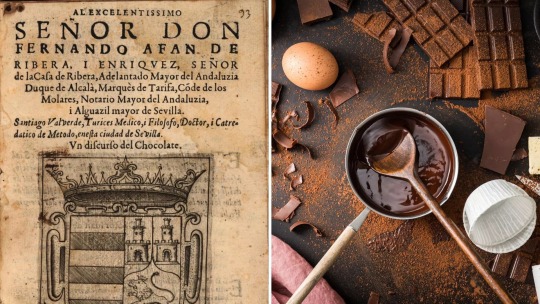
A rare 400-year-old book titled "Un Discurso del Chocolate", regarded as the oldest known book solely dedicated to chocolate, is hitting the auction block in Portugal.
This prized artefact, printed in Seville in 1624, is one of just three surviving copies of this work, written by Santiago de Valverde Turices, a Spanish doctor and academic.
Until now, only two other copies of the work were known to exist, one housed in the national library in Madrid and the other at the University of San Diego in California, according to Francisco Brito, a consultant at the Anno auction house, as reported by Portugal’s Publico newspaper.
"Un Discurso del Chocolate" contains a fusion of scientific inquiry, practical advice, recipes and cultural commentary. Divided into five parts, the book offers insights into the multifaceted nature of chocolate and its effects on the human body.
Notably, Turices cautions against the potential of chocolate to incite choleric tendencies in its consumers. Drawing from the medieval and early modern concept of bodily humors, he warns of chocolate's "hot, humid, and greasy" nature, which he believes can lead to irritability and anger.
Choco-Lore: A Bitter-Sweet History of The Confectionary
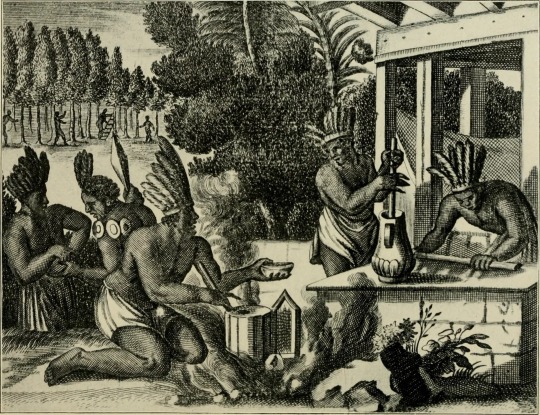
Native Americans roasting and grinding the beans, and mixing the chocolate in a jug with a whisk. Credit: Wikimedia Commons
The domestication of cocoa beans traces back at least 5,300 years to the region now known as southeast Ecuador's Zamora-Chinchipe Province, where the Mayo-Chinchipe culture first cultivated them. The practice was then introduced to Mesoamerica.
The indigenous peoples of Central America, particularly the Olmecs, Maya, and Aztecs, considered the cacao tree to be sacred, and its beans were used to create a bitter, frothy beverage called "xocolātl", which means "bitter water" in Nahuatl.
Legend has it that when Spanish explorers, led by conquistador Hernán Cortés, arrived in the Americas in the early 16th century in search of gold and riches, they discovered the smooth beverage.
Following the Spanish conquest of the Aztec Empire, xocolātl found its way to Europe. The Spanish soon adapted the indigenous recipe by adding sugar or honey to sweeten the bitter drink, as well as other spices like cinnamon and vanilla.
At first, it was consumed primarily as a drink, but eventually, chocolate houses began to emerge across Europe, particularly in Spain, Italy, and France in the 17th century.

A page from "Un discurso del chocolate" by Santiago de Valverde Turices. Credit: University of California
The recipes contained within Turices book, sourced from experts both in Spain and the "new world," provide a glimpse into the historical preparation and consumption of chocolate.
Turices advocates for the inclusion of annatto seeds, known as achiote, to enhance the taste, colour, and flavour of chocolate, particularly for people with choleric and sanguine temperaments.
The book, priced at €2,000, is among nine pieces being auctioned from the collection of José Augusto Correia de Campos, a Portuguese military officer, author, and archaeologist who passed away in 1977.
#Culture#Food 🍲 🍱 🥘 & Drink 🥤 🍹 🍺#Chocolate 🍫#Rare | 400-Year-Old | Chocolate 🍫 Book 📕#Auction#Portugal 🇵🇹#Un Discurso del Chocolate 🍫
0 notes
Text
Bats Are In Trouble. That’s Not good For Anyone Who Likes Mezcal, Rice or Avocado
Some of Our Favorite Foods and Drinks Rely on These Oft-Misunderstood Mammals, Which are Facing Multiple Threats
— By Whitney Bauck | Thursday 21 March 2024
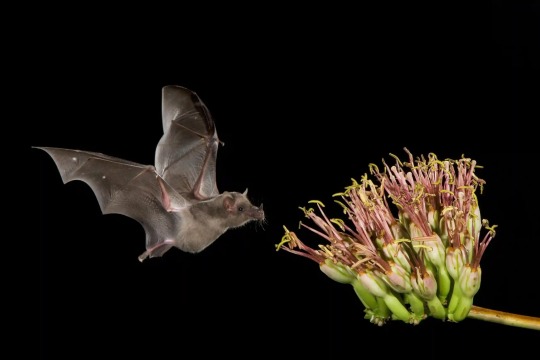
A Mexican long-tongued bat approaches an agave blossom in Tucson, Arizona, in 2006. Photograph: Rolf Nussbaumer/Alamy
If You’ve Ever Enjoyed Coffee ☕️, Tomatoes 🍅, Corn 🌽, Bananas 🍌, Mangoes 🥭, Walnuts, Chocolate 🍫, Tequila 🍺 or Mezcal, You May Just Owe Bats a Thank-You.
While bats are often the subject of fear and scorn – they’re fixtures in Halloween decor and haunted-house imagery, and are frequently portrayed as harbingers of doom – their presence is often a sign of a thriving ecosystem. Some of our favorite food and drinks would be much less plentiful, or even nonexistent, without them.
Bats play a few significant roles in human food systems. Some serve as a form of natural pest control by feeding on insects that can destroy crops like corn and pecans. Others pollinate species like bananas, coconuts, avocados and agave, a role many people associate with bees and butterflies. And some fruit-eating bats help maintain wild plant populations through seed dispersal – think mangoes, cashews, figs and almonds.

Bats fly out of a cave at sunset to feed in Ratchaburi, Thailand, on 12 September 2020. Photograph: Lauren DeCicca/Getty Images
Despite all the ways that bats help ecosystems thrive, “they often get forgotten” in conservation conversations, and in people’s estimations of what it takes to maintain sustainable food systems, said Kristen Lear, who works at Bat Conservation International. Whether it’s because we just don’t notice bats (as nocturnal animals, they’re certainly not easy to observe) or because we tend to associate them with dark and spooky things, bats are rarely championed. But as threats from habitat destruction, disease and climate change mount, it’s time that changed.
No Bats, No Tequila
Most of the time when you order a margarita, you probably aren’t thinking about bats – but maybe you should be. Tequila is made from agave, and agave plants have long relied on bats for both pollination and seed dispersal.
The Mexican long-nosed bat, which has co-evolved with agave for millions of years, is a fuzzy little gray-brown creature that uses its 3in-long tongue to slurp nectar from agave flowers that bloom at night. This migratory species travels from west Texas and south-western New Mexico down into Mexico each year, keeping pace with the blooming periods of agave and flowering cacti.
But as demand for tequila and mezcal – another spirit made from agave – has grown, the plant is increasingly being harvested at scales that put these migratory bats at risk. After having been appreciated in Mexico for hundreds of years, agave-based spirits are becoming increasingly popular abroad, and nowhere are they more sought-after than in the US, where about 80% of the world’s tequila is sold.
“Agave spirits from Mexico are very trendy now. Probably that trend started 10 years ago, but in the last four or five years, it has been intense,” said Diana Pinzón, a forestry engineer who works with small-scale mezcal producers. “It’s a big problem for agaves endemic to Mexico, and for the bats and all the biodiversity around the ecosystems where the agaves grow.”
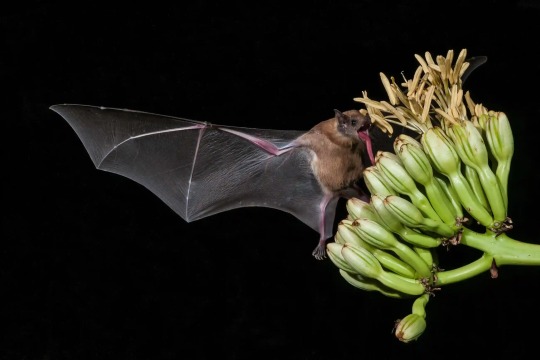
A bat feeds on agave blooms in Green Valley, Arizona, in 2012. Photograph: Michelle Gilders/Alamy
US thirst for agave-based spirits, and the money that can be made from selling them, is driving growers to harvest at a scale and in a manner that’s not sustainable long-term, according to Pinzón. In many places, agave plants are chopped down before they’ve had time to bloom, leaving bats that rely on the flowers’ nectar with one less food source.
Producers can grow new agave by working with “baby” shoots sent out by parent plants, but without bats cross-pollinating them, the new plants are all clones and lose genetic diversity over time. Pinzón fears this will make the plants less resilient in the face of climate threats and extreme weather.
“These two species evolved together for the last 10m years. If you lose one, you lose the other,” she said.
Pinzón is building a small-label brand called Zinacantán Mezcal with a fourth-generation agave grower who leaves 20% of the crop in the field for the bats, and believes that limiting the amount of production of agave-based spirits is the only path forward for any legitimate claim to sustainability.
“The demand is like cars in the city. If you build a new freeway [to fix traffic], more cars will just end up on the road,” she said. “So the [agave] projects need to put limits and say: ‘OK, we can make that quantity [of spirits] every year and no more.’ We need to recognize and take action to mitigate our ecological impact.”
The Bug-Eaters
Troy Swift has been farming pecans in Texas since 1998, but hadn’t thought about building bat houses near his orchards until recently. He was first inspired when Merlin Tuttle, a legendary bat conservationist, visited his farm and suggested it. “He said: ‘Troy, with the biodiversity you have here, you really might want to consider using bats as part of your pest-control program,’” Swift recalled.
It wasn’t long before Swift started building his own bat houses. Within six months, bats had moved in. He now has 17 bat houses on his property, and is working with Tuttle’s organization to quantify the impact that the bats have on his crop. Together, they’ve used echolocation technology and guano (bat dropping) DNA sampling to learn that there are at least seven species of bats living on Swift’s farm. They also found that over the course of six weeks, the bats had eaten more than 100 species of insects.

A bat flies over water in 2022. Photograph: Paul Colley/Getty Images/iStockphoto
They’re still trying to gather enough data to prove whether or not the bats are helping control the specific pest insects that eat pecans, but having found that the bats eat mosquitoes, flies and pests that bother livestock is already enough to convince Swift that bats have a role to play on farms.
“What we’re trying to do is leverage the use of bats into all agriculture and teach farmers that these bats are really your friends,” Swift said.
Other studies have already concluded that bats are providing farmers free pest-control services, whether they know it or not. Bats save more than $1bn a year in crop damage and pesticide use in the US corn industry, and more than $3bn a year across all agricultural production, according to Jade Florence, a biologist at the US Fish and Wildlife Service, who has worked on bat conservation efforts.
Simply having bats around, even when they’re not feeding, helps keep pests under control, according to Lear of Bat Conservation International. “The mere presence of bats in agricultural fields can actually suppress the activity of those insects,” she said.
How To Help Bats Under Threat
For all the good they do for food systems, bats face numerous threats. “Many species around the world, including here in the US, are undergoing some sort of habitat loss, whether that’s disturbance to their roost sites in caves or mines or trees, or loss of foraging habitat – loss of forests or agricultural areas that have healthy insect populations,” said Lear. Other threats include the extreme weather caused by the climate crisis and diseases like white-nose syndrome, a fungal disease that has decimated North American bat populations.
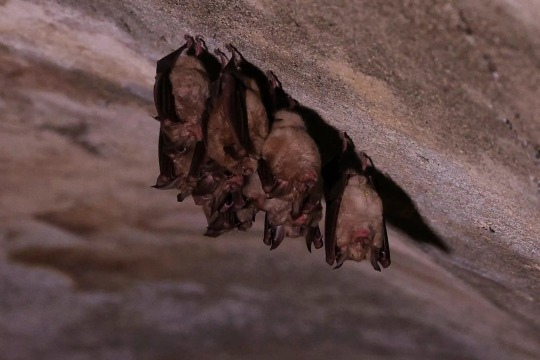
Bats hang from the ceiling of a tunnel in Tirana, Albania, on 15 March 2023. Photograph: Franc Zhurda/AP
So what can be done? Lear has been working on a project with 60 partners across the US and Mexico to plant 115,000 agave plants in the Mexican long-nosed bats’ migratory path. Her organization recommends exploring nature responsibly (for example, respecting cave closures in order to not expose bat populations to new pathogens), protecting old trees that can serve as bat roosts, keeping cats indoors where they can’t harm bats and providing a water source in arid environments.
People who want to go one step further can build or buy a bat house and plant a bat-friendly garden with some native night-blooming flowers to attract nocturnal insects that bats can feed on. (Besides having a positive ecological benefit, “it’s just fun” having bats around, said Swift, who loves watching them emerge at dusk to hunt insects.)
But Lear said you can also help by doing something even simpler: talking about bats and why we need them. “The more we have people doing that to their friends and families, the more it will take root in their brains,” she said. “Over time, that will help gain public support for bat conservation.”
#Wildlife | Our Unequal Earth | Food (Environment) | Animals | Agriculture | Farming#Food (Global) | Food 🍲 🍱 🥘 & Drink 🍺 Industry | Features#The Guardian#Whitney Bauck
0 notes
Text
How the World’s Rarest Wine Is Made! It's a Painstaking Process to Create Royal Tokaji's Essencia.
— By Mike DeSimone and Jeff Jenssen | Robb Report | February 6, 2024
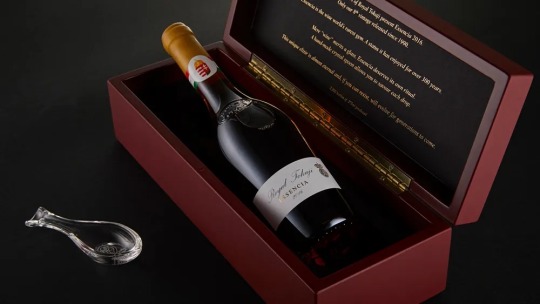
Royal Tokaji
One of the biggest heartbreaks of making wine is a lost vintage, which is usually due to weather conditions before grapes have a chance to fully mature. This has been the case in several years since 2009, the last time—until now—that Royal Tokaji was able to produce bottles of its ultra-rare Essencia. The conditions weren’t right for azsú berries in five out of the six vintages between 2009 and 2016 (the current release), but 2013 offered the biggest heartache of all.
“I think most producers in the region would agree that 2013 is one of the greatest vintages in Tokaji, ever. We had perfect conditions for azsú, and we had amazing quantity as well,” Royal Tokaji managing director Charlie Mount tells Robb Report. “We had a lot of Essencia dripping, but after five or six years in our cellar, we couldn’t find anything that we thought was worth bottling. And it was one of the most painful decisions we’ve ever had, having a huge amount of Essencia not meeting our standards and having to decide not to release the 2013.”
Although neither 2014 nor 2015 provided ideal conditions for enough quality azsú berries to produce Essencia, the summer and fall of 2016 offered perfect circumstances to capture the precious free-run juice (more on that later) that goes into making this prized elixir. And prized it should be. Only the eighth vintage of Essencia released in the winery’s 34-year history, sipping Royal Tokaji 2016 Essencia from specially designed crystal spoons that reveals its deep amber hue and aromas of dried apricot, ripe summer peach, and honeycomb. It rolls over the tongue like syrup with nimble viscosity and a sumptuous vein of acidity that keeps its inherent sweetness from overpowering its flavors of apricot nectar, peach pie, candied orange peel, and fresh honey that leaves a trail of tangerine zest in their wake.

The Grapes Falling Prey to “Noble Rot”
Meaning “dry” in Hungarian, azsú berries are grapes that have been afflicted with Botrytis cinerea, the grey mold called Noble Rot that is responsible for the creation of Tokaji Azsú as well as Sauternes and Spätlese and Beerenauslese Riesling. Unlike common household molds, Botrytis requires an optimal setting to do its work; if it is present in a season that is relentlessly wet, it will ruin the grapes it’s growing on, making them useless for winemaking. But a period of humidity, especially one with cool, foggy mornings, that precedes a dry period just before harvest creates an ideal situation. The fungus dehydrates the grapes, which increases the proportion of fruit sugars and acids, offering a sweeter, more intensely flavored berry from which to make wine. Affected grapes shrivel to the point that they look like raisins.
In regular azsú wines, botrytized grapes are collected in large baskets known as puttony and added to 136-liter barrels of base wine. The number of baskets of sweet grapes added to the base wine give the Tokaji Aszu the Puttonyos rating of either five or six Puttonyos. For a Tokaji Aszu wine to be labeled today as five Puttonyos, it must have at least 120 grams per liter of residual sugar and a wine labeled as six Puttonyos must have at least 150 grams per liter of residual sugar. Essencia’s sugars can run between 450 and 600 grams, requiring strong acidity to balance out the sugars; Royal Tokaji’s 2016 weighs in at 534.6 g/l of sugar.
Although Tokaji Azsú has been a favorite of noblemen, poets, and artists for centuries, Tokaji Essencia is in a league of its own. While Louis XIV may have proclaimed that Tokaji is “The King of wines, the wine of Kings,” Hugh Johnson OBE, the esteemed British wine writer who founded Royal Tokaji in 1990, has been known to call its Essencia “medieval Viagra.” Each 375-milliliter bottle of Essencia contains the juice of 88 pounds of dehydrated berries, which comes out to about 50,000 grapes; compare that to an average 750 ml bottle of dry wine, which is made with about two and a half pounds or approximately 200 grapes. The painstaking production process involves picking the finest botrytized grapes from the best plots and then, as Mount says, “It’s a question of waiting.” The term “low-intervention winemaking” is tossed about with abandon in the wine world, but Essencia is truly the epitome of the style.

Royal Tokaji’s Wine Director Zoltán Kovács
After harvesting, shriveled Furmint, Harslevelu, and Muscat Blanc grapes that have lost 80 percent of their water are placed on racks and left to drip. “We don’t press them or apply any pressure so a tiny amount of liquid drips through a grating at the bottom of the collecting vat. We draw it off from time to time, we keep every grape variety and every site separate, and we do an initial selection,” Mount says. The juice absorbs atmospheric liquid from the high humidity wine cellar; naturally occurring yeast from the cellar settles on the surface and a top-down spontaneous fermentation takes place. Up to 70 percent of that free-run juice is poured into appropriately sized glass demi-johns; as grapes from vineyard plots are kept separate, the containers vary in size from 10 to 50 liters. The entire process takes at least five to seven years; Mount continues, “All along we’re waiting and tasting and towards the end we’ll make a final selection of the batches to be blended and bottled as Essencia.”
Although a bottle of wine boxed with a crystal spoon can seem like a bit of a gimmick, the viscosity makes sipping from a spoon rather than a glass a much more efficient means of imbibing with minimal loss. After all, 15 percent of the initial juice has already been lost sticking to the grates, and up to 30 percent more is discarded prior to blending. Only 2,300 bottles of this treasured liquid were made (priced at $1,416 each), and each one holds roughly 25 tablespoon-sized pours; you seriously want to devour every last drop. If you can’t get your hands on a full bottle but are dying to give it a try, a select group of restaurants such as Oiji Mi and Gabriel Kreuther in New York City have bottles and crystal spoons on hand for your sweet sipping pleasure.
— Mike DeSimone and Jeff Jenssen, also known as the World Wine Guys, are wine, spirits, food, and travel writers, educators, and hosts. They have been featured guests on the Today Show, The Martha Stewart Show, Better TV, and the CBS, FOX, and NBC networks. They also write Robb Report's weekly newsletter The Oeno Files.
#Food & Drinks 🥤 🍺 🍹#Wine 🍷#Royal Tokaji's Essencia#World’s Rarest Wine 🍷#Painstaking Process#Mike DeSimone and Jeff Jenssen#Food 🍲 🍱 🥘 and Drinks 🥤🍺 🍹
1 note
·
View note
Photo

Next stop on our Myrtle Beach Foodie Tour is a restaurant everyone’s barking about - literally! 🐶❤️ 🐶@sneakybeagle.mb The food is incredible (swipe to see), the menu is full of Star Wars’ themed food, which is a check for us Disney fans, and Hello, Puppies everywhere! We met Max, the bulldog, today who was so cute! 🐶 We hit it at the right time too, because Saturdays are Happy Hour Food and Drink Specials all day! 🌮🍱🍤🍔🥪🥙🍹🍺 #myrtlebeachfood #myrtlebeachfoodie #foodie #amazingfood #bestfoodpics #foodphotography #starwars #starwarsfood #wookie #jedi #doglovers (at The Sneaky Beagle) https://www.instagram.com/p/CYNEO19rO68/?utm_medium=tumblr
#myrtlebeachfood#myrtlebeachfoodie#foodie#amazingfood#bestfoodpics#foodphotography#starwars#starwarsfood#wookie#jedi#doglovers
0 notes